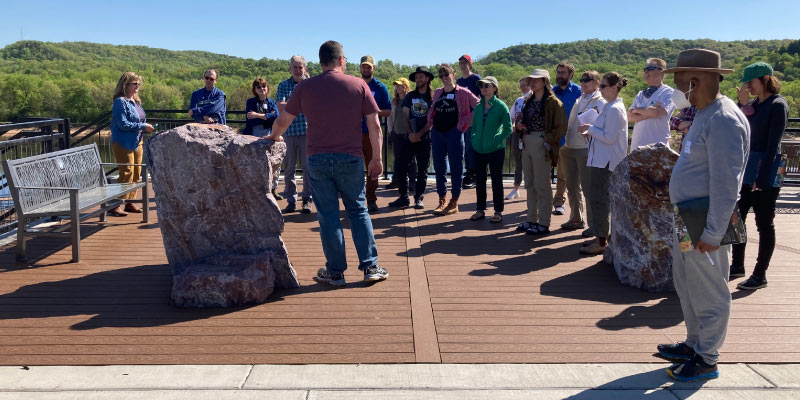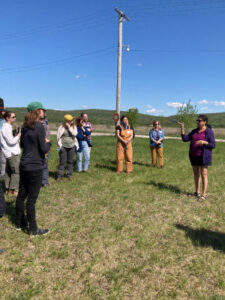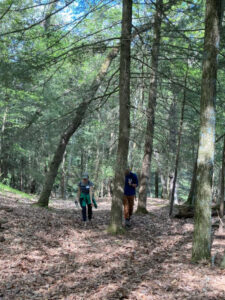Faculty and graduate students with the Nelson Institute’s Center for Culture, History, and Environment (CHE) participated in the annual Place-Based Workshop (PBW) where they spent two days immersing themselves in the history and culture of the region north and west of Madison. The two-day workshop held in mid-May included a bus tour that visited Springfield Hill, the Badger Lands and Yellow Thunder Memorial in Sauk County, and an experiential workshop on Blackhawk Island, part of the Upham Woods Outdoor Learning Center.

Held annually since CHE’s inception in 2007, but interrupted by the pandemic, the PBW hosts graduate students and CHE faculty associates on a field trip to explore the tangled relationships between nature and culture. The workshop’s goal is to offer inspiration for faculty and graduate student projects and dissertations as well as to stimulate conversation and collaboration within the CHE community.
“I’m so pleased that we were able to gather this year after having to postpone the PBW for the last two years,” shared Anna Andrzejewski, CHE director. “It is at the core of what CHE folks do: understand the complicated relationships of people and place.”
This year’s workshop focused on how the landscape between the UW campus and Upham Woods has been shaped by geological forces and human communities over millennia. Students and faculty began the workshop in the afternoon of May 15 at Holy Wisdom Monastery in Middleton, Wisconsin, where graduate students in the CHE Methods class presented their research on Blackhawk Island and Curt Meine gave a keynote presentation.
Meine, a conservation biologist, environmental historian, writer, and adjunct professor at the University of Wisconsin–Madison, relayed the cultural history of the land, telling stories about the landscape corridor from the UW to Upham Woods. In particular, Meine explored the many connections between culture and conservation that have played out in this dynamic landscape.
The following day began with taking a bus to Springfield Hill, between Madison and the Wisconsin River. Participants learned about bedrock and glacial geology, the Black Hawk War, and Aldo Leopold’s “Prairie Birthday” essay. As the tour moved north to Sauk Prairie, Eric Carson, geologist with the Wisconsin Geological and Natural History Survey, discussed the complicated history of the Wisconsin River from the Wisconsin Dells to the point where it enters the Driftless region.

“It’s a great area geologically [speaking],” Carson shared. “From a landscape perspective, you go from some of the youngest landscapes in Wisconsin to some of the oldest.”
Next, the workshop stopped by Mąą Wakącąk (Sacred Earth), the portion of the former Badger Army Ammunition Plant now reclaimed by the Ho-Chunk Nation. There, the group visited with Melanie Tallmadge Sainz, a Ho-Chunk artist and founding director of the Little Eagle Arts Foundation. Meine presented on the critical and long-term history of the Ho-Chunk Nation, Euro-settlement, and U.S. military presence in the area. “It’s a place of transformation. In just one century it went from tallgrass prairie to agriculture to industrial use. Now, it is a place devoted to restoration and reconciliation,” Meine explained.

The third stop was the memorial to Chief Yellow Thunder (Wakąjazi), an important leader of the Ho-Chunk Nation in the 1800s. “Yellow Thunder was a critical figure in the history of the Nation’s removal and reclaiming of their ancestral homelands,” Meine said. “We were fortunate to have Kristin WhiteEagle give our visit to the memorial site the dignity that it deserves.” WhiteEagle, a Ho-Chunk Nation tribal legislator and member of the Sauk County Board of Supervisors, joined the PBW at the Yellow Thunder Memorial.

The tour ended at Blackhawk Island in Upham Woods, a residential outdoor learning center managed by the UW–Madison Division of Extension. Here, workshop participants split into groups, explored the area using a 1961 trail guide, and sat in nature while taking into account some of the knowledge they had gained from the bus tour and student presentations.
“One of the coolest things that we did once we got to Upham Woods, having heard all these stories, was we went to Blackhawk Island, and we all sat quietly for 10-15 minutes,” said graduate student Rudy Molinek. “That moment was great to have all these connections and thoughts swirling around in your head and then having quiet time on this island to think it through.”

Meine recapped the workshop with a reminder that history “involves not only what we humans create, but the world that we inhabit, care for, and find our place in. The Place-Based Workshops help us appreciate that rich history by drawing upon all these different ways of understanding, knowing, and being in the world.”
Learn more about CHE graduate programs and how you can support the program.